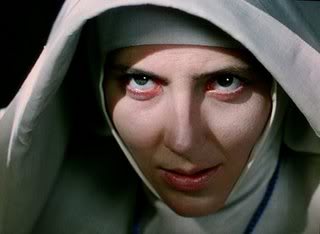 He's often accused of being excessive, but that's one big reason to go see his movies. I want the excess: with excess, there's a spectacle to be seen, and "Dr. Parnassus" doesn't disappoint. There is an impossibly remote and yet, immense monastery, a tawdry yet fantastic traveling theater that looks centuries old, and extended scenes that take place in the "Imaginarium" - a dreamscape that's set off - though not well-controlled - by the imaginations of the souls who enter it. All this is a visually fascinating treat, and the movie looks and feels unique.
He's often accused of being excessive, but that's one big reason to go see his movies. I want the excess: with excess, there's a spectacle to be seen, and "Dr. Parnassus" doesn't disappoint. There is an impossibly remote and yet, immense monastery, a tawdry yet fantastic traveling theater that looks centuries old, and extended scenes that take place in the "Imaginarium" - a dreamscape that's set off - though not well-controlled - by the imaginations of the souls who enter it. All this is a visually fascinating treat, and the movie looks and feels unique. Where Gilliam really IS guilty of excess is in the script department. Scenes take place that set up the action admirably, but the film often returns to expository storytelling. It's totally unnecessary. One reviewer noted that Gilliam throws you into the action with the first scene; he does. Why then does he return to tell you more about the background? We get it.
Once "Imaginarium" gets going, it really goes and pulls you along. With a plot that involves wagers with a derby-wearing devil, an imperiled family, a shady and mysterious stranger, and rich ladies lusting after spiritual fulfillment, Dr. Gilliam is like Dr. Parnassus's storyteller; he has to keep spinning his tale, or the world will collapse. He's a good spinner.
 There's a haunted quality to the film that's clearly intended - and one that isn't. Heath Ledger as Tony is the one of the three main characters in the story. He drives the action forward, though we don't know until the climax what his motives are. By that time, Ledger is gone from the movie.
There's a haunted quality to the film that's clearly intended - and one that isn't. Heath Ledger as Tony is the one of the three main characters in the story. He drives the action forward, though we don't know until the climax what his motives are. By that time, Ledger is gone from the movie.When he lost his young star, Gilliam finished the small number of un-shot sequences - unfortunately, they are key scenes - with different actors. The explanation for why Tony has a different face is plausible - in the Imaginarium, people look the way YOU want them to. The device works, but ultimately it reminds you that Ledger is dead and every mention of mortality - an important theme in this film - has a discomfiting edge.
 Christopher Plummer hands in a wonderful performance as a boozy, decrepit Parnassus that put me in the mind of King Lear. He's an actor that seems to truly inhabit his roles more and more. Tom Waits as Mr. Nick is a scrupulously fair scoundrel. Waits is not just underrated - he rarely seems rated at all; but his concert and album work is so character driven, that it never surprises me when he turns in a great performance like he does here. He's understated yet seems to be having more sly fun than anyone. The model Lily Cole as Parnassus's daughter looks like a doll's head sewn on a gawky body, but she's quite good and perfectly cast. Verne Troyer, who'll forever be known as Mini-Me, is the best he's ever been; he understands the style and he keeps the pace up.
Christopher Plummer hands in a wonderful performance as a boozy, decrepit Parnassus that put me in the mind of King Lear. He's an actor that seems to truly inhabit his roles more and more. Tom Waits as Mr. Nick is a scrupulously fair scoundrel. Waits is not just underrated - he rarely seems rated at all; but his concert and album work is so character driven, that it never surprises me when he turns in a great performance like he does here. He's understated yet seems to be having more sly fun than anyone. The model Lily Cole as Parnassus's daughter looks like a doll's head sewn on a gawky body, but she's quite good and perfectly cast. Verne Troyer, who'll forever be known as Mini-Me, is the best he's ever been; he understands the style and he keeps the pace up. Heath Ledger is harder to assess. His arrival on the scene as the victim of a failed murder attempt is unsettling, but his magnetism wins you over. In the scenes where he takes on the role of Parnassus's carnival barker, he's persuasive, appealing, and ultimately, wonderfully insidious. That his performance leaves you wanting more is probably the saddest thing about this meringue of a movie.
Yes, it's flawed. Yes, it's Heath Ledger's last screen work. As long as you go in knowing that, you'll find it's really a touching little story in a huge, fantastical universe spun out of one of the best imaginations to ever work in film.




No comments:
Post a Comment